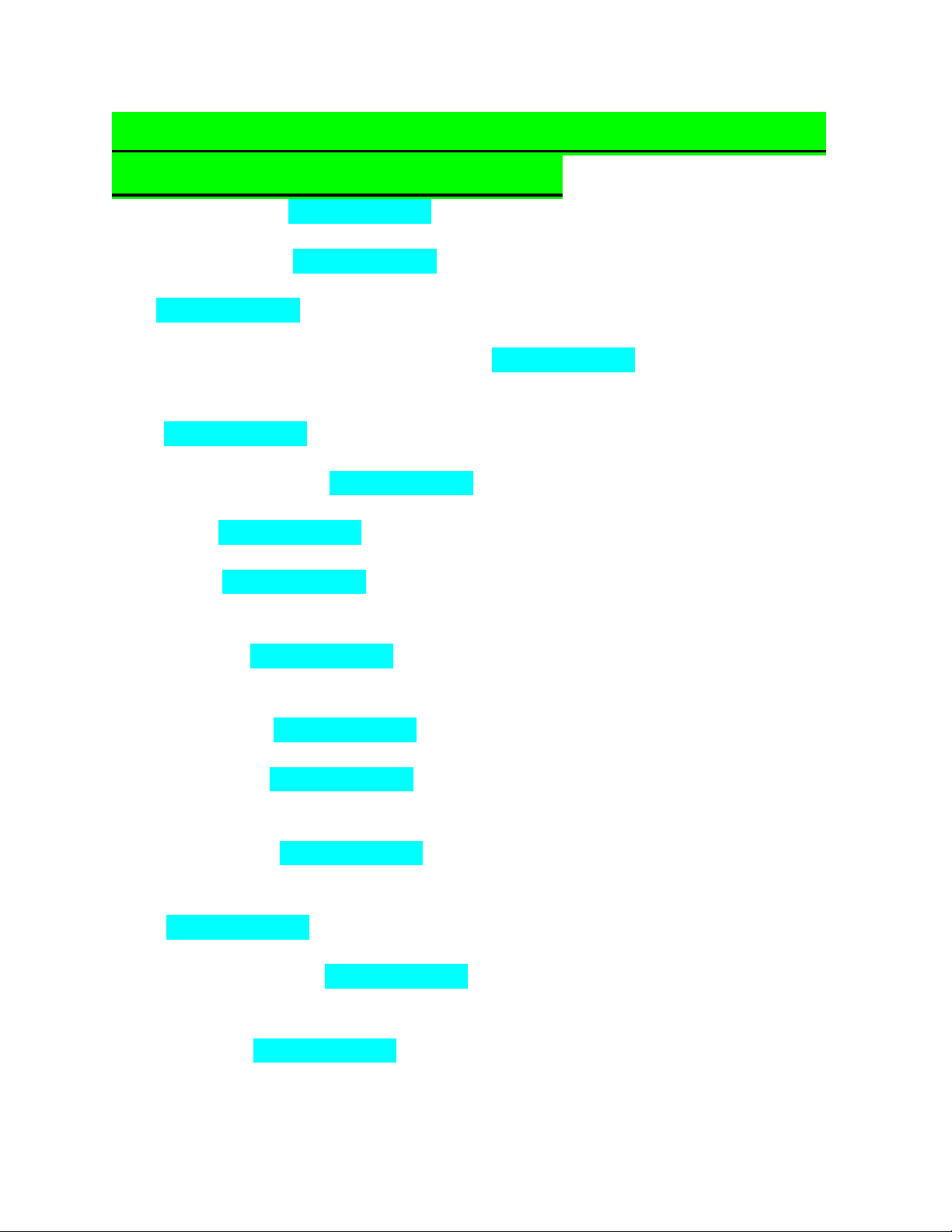
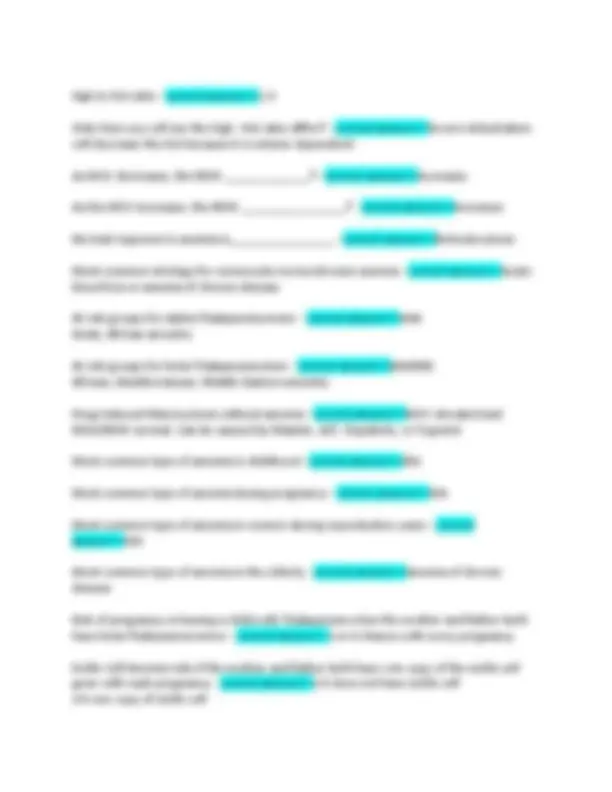
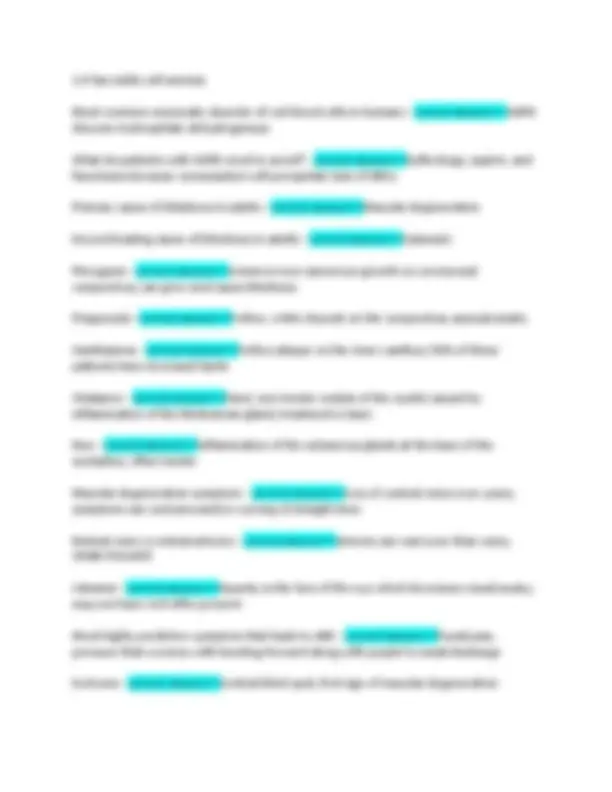
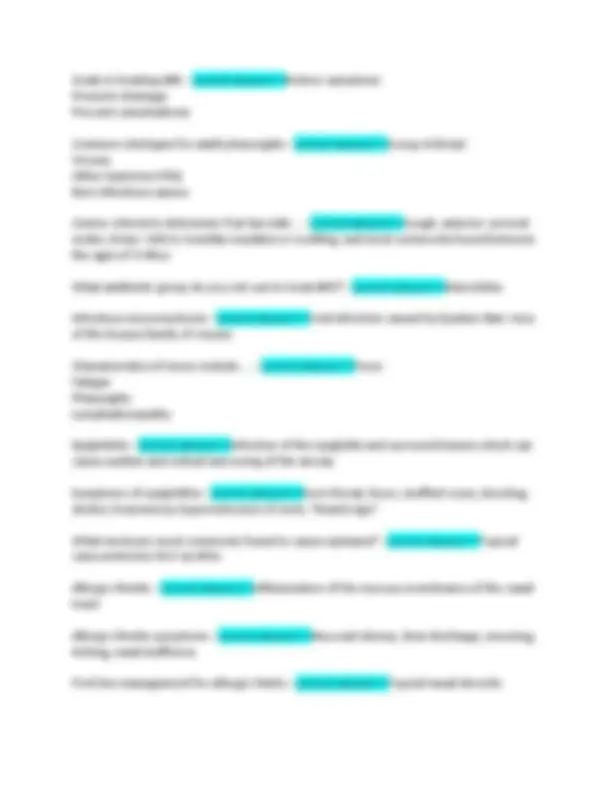


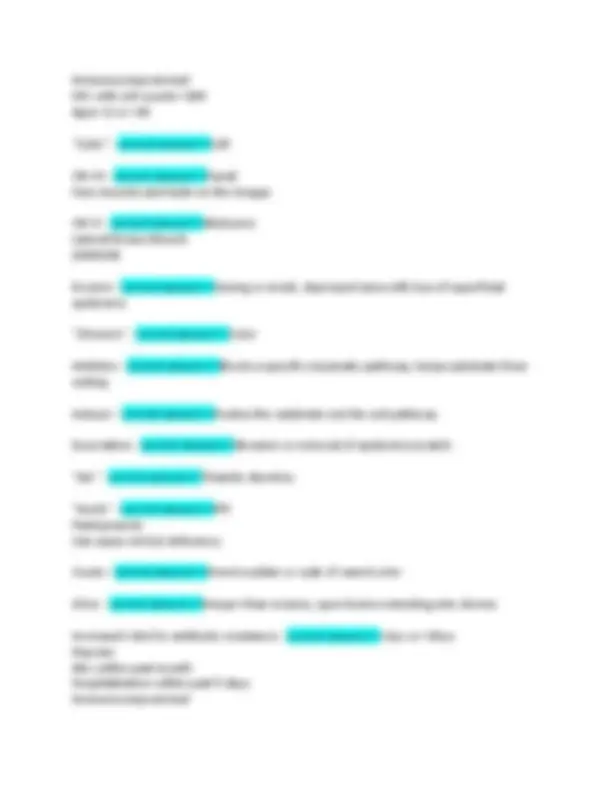
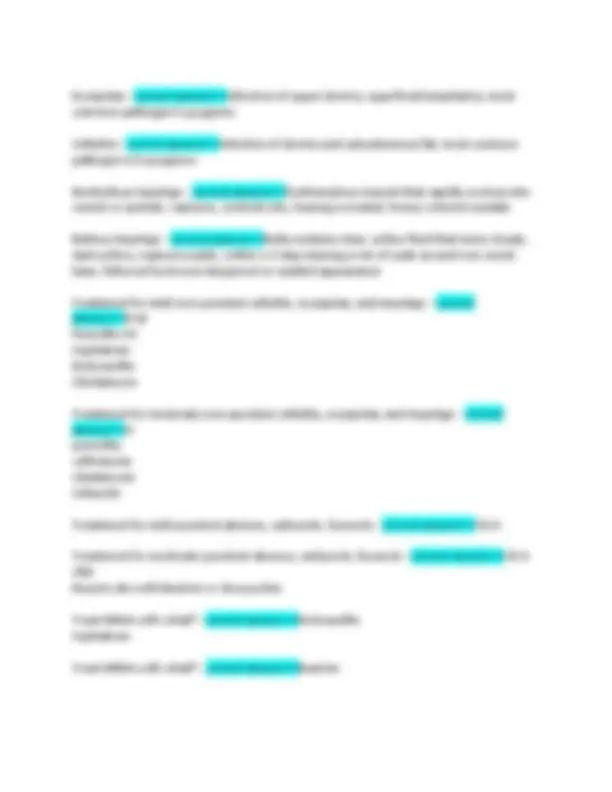
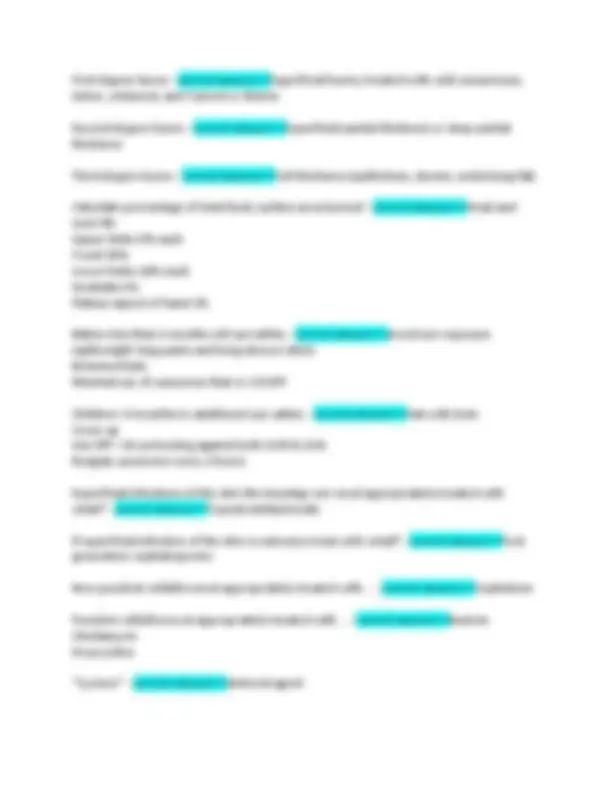
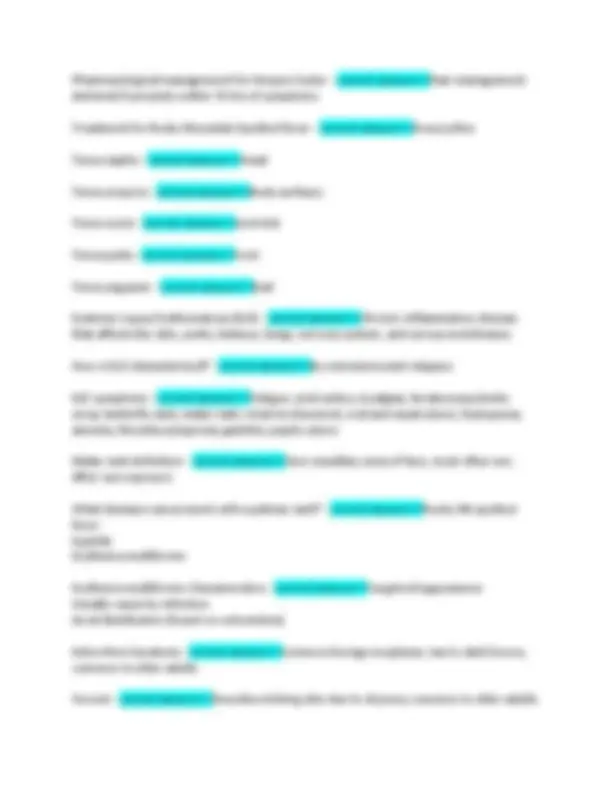
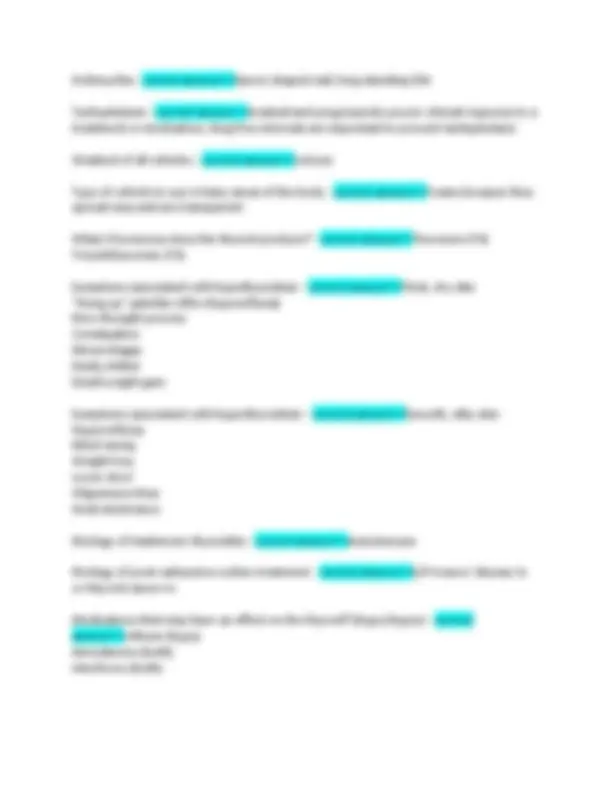
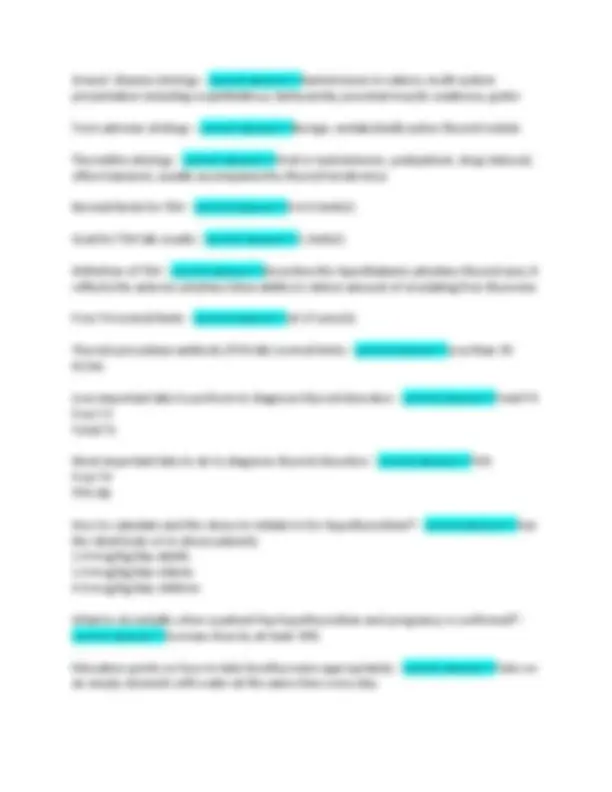
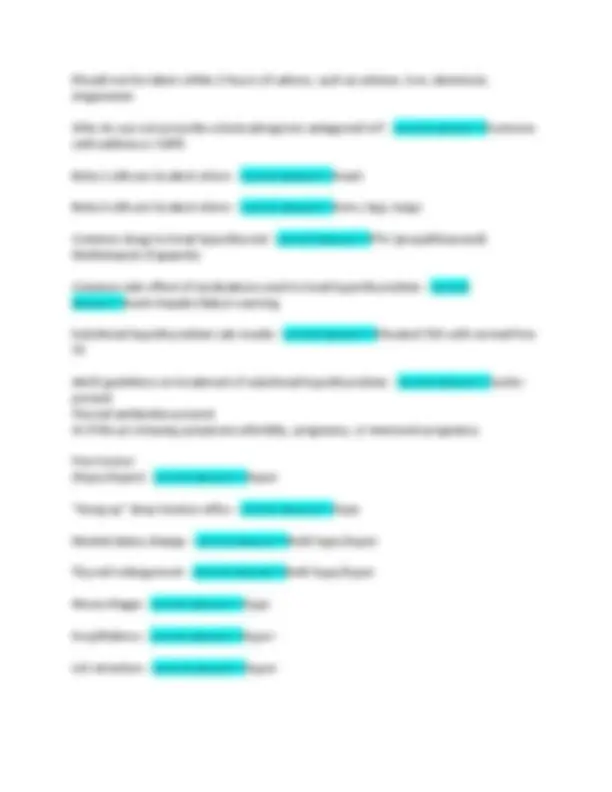

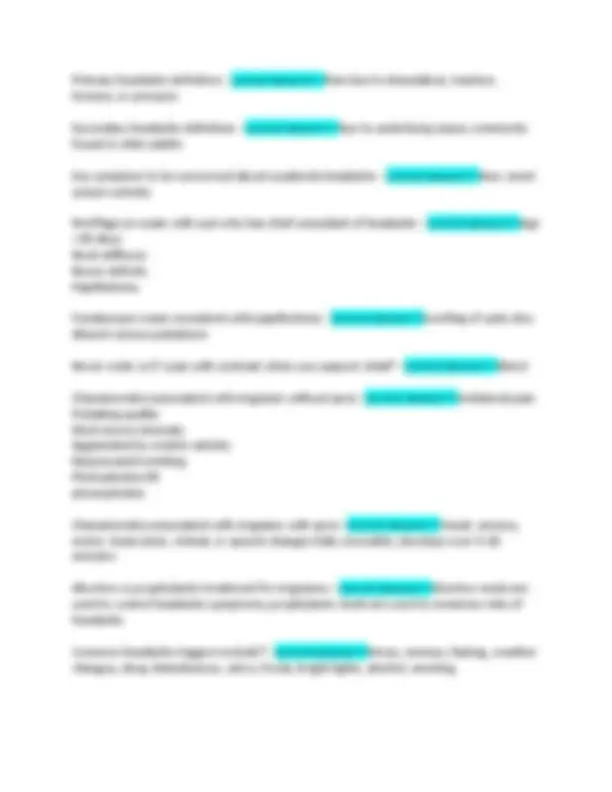
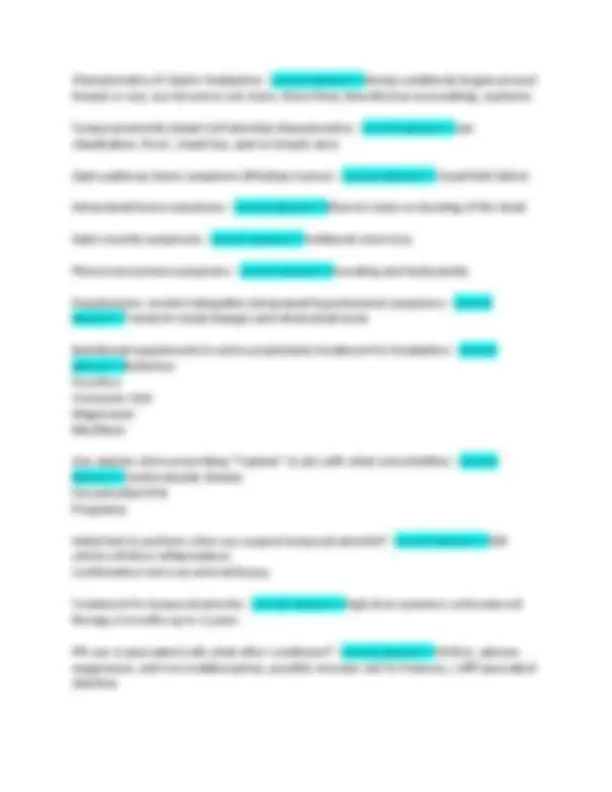
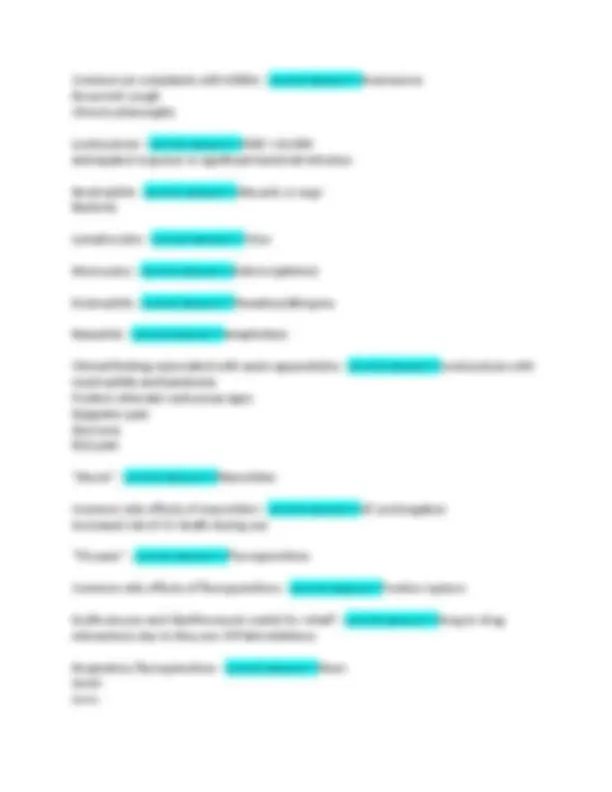
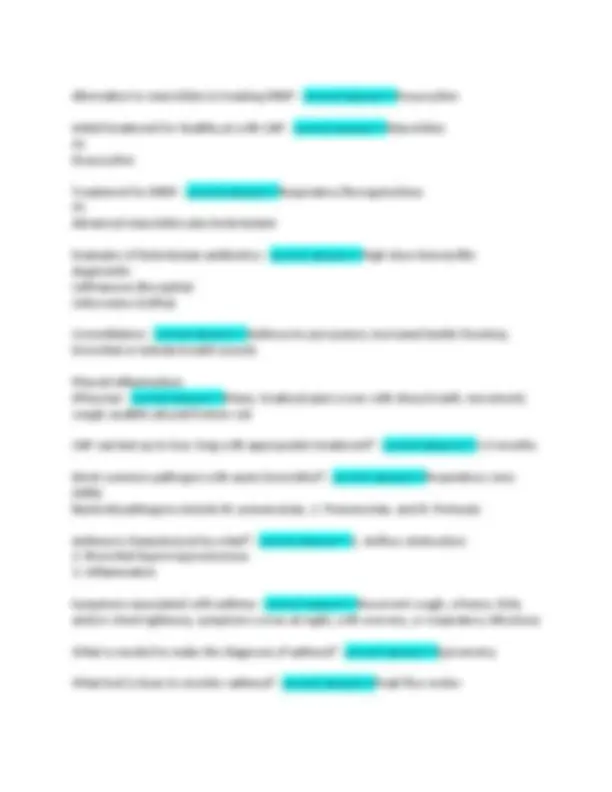
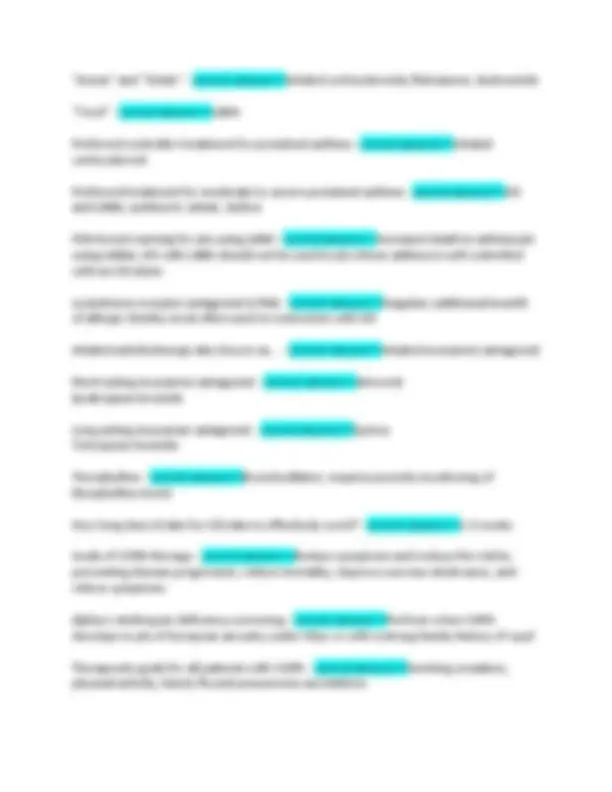
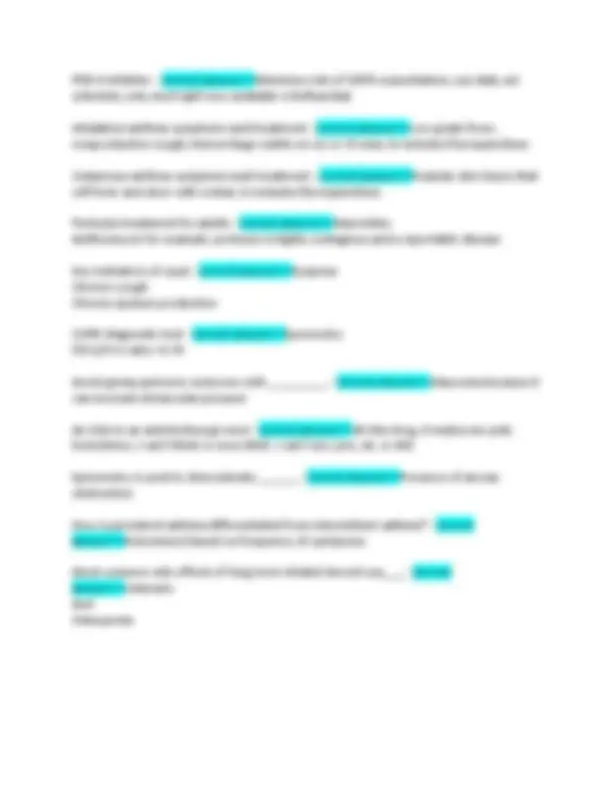


Study with the several resources on Docsity

Earn points by helping other students or get them with a premium plan


Prepare for your exams
Study with the several resources on Docsity

Earn points to download
Earn points by helping other students or get them with a premium plan
Community
Ask the community for help and clear up your study doubts
Discover the best universities in your country according to Docsity users
Free resources
Download our free guides on studying techniques, anxiety management strategies, and thesis advice from Docsity tutors
Microcytic Anemias - correct answer>>IDA, Thalassemia, Lead Toxicity Macrocytic Anemias - correct answer>>B12 Deficiency and Folate deificiency IDA - correct answer>>Microcytic, hypochromic Patient Presentation with microcytic anemia - correct answer>>Weakness, headache, irritability, fatigue, and exercise intolerance. Worsening of angina or dementia TIBC - correct answer>>Elevated with IDA Average lifespan of RBCs - correct answer>>100-120 days RDW <15% - correct answer>>Longstanding anemia in that all cells are small RDW > 15% - correct answer>>New onset anemia; There is a mixture of normal and small RBCs Iron Rich foods - correct answer>>Organ meats, red meats, dried peas and beans, whole grains, and dark, green, leafy vegetables Iron Replacement - correct answer>>150-200 mg/d Elemental Iron x4-6 months Beta Thalassemia - correct answer>>Avoid excessive iron consumption and will need genetic counseling
Typology: Exams
1 / 27

This page cannot be seen from the preview
Don't miss anything!




















Microcytic Anemias - correct answer>>IDA, Thalassemia, Lead Toxicity Macrocytic Anemias - correct answer>>B12 Deficiency and Folate deificiency IDA - correct answer>>Microcytic, hypochromic Patient Presentation with microcytic anemia - correct answer>>Weakness, headache, irritability, fatigue, and exercise intolerance. Worsening of angina or dementia TIBC - correct answer>>Elevated with IDA Average lifespan of RBCs - correct answer>> 100 - 120 days RDW <15% - correct answer>>Longstanding anemia in that all cells are small RDW > 15% - correct answer>>New onset anemia; There is a mixture of normal and small RBCs Iron Rich foods - correct answer>>Organ meats, red meats, dried peas and beans, whole grains, and dark, green, leafy vegetables Iron Replacement - correct answer>> 150 - 200 mg/d Elemental Iron x4-6 months Beta Thalassemia - correct answer>>Avoid excessive iron consumption and will need genetic counseling Alpha Thalassemia - correct answer>>Asians, Mediterranean origin, avoid inappropriate exposure to iron, no therapy needed in minima and minor Liver - correct answer>>Where excess iron is stored Thalassemia Lab Results - correct answer>>Decrease hct, hgb, MCV, and MCH Normal RDW, serum iron, serum ferritin, and TIBC IDA Lab Results - correct answer>>Decrease in hgb, hct, MCV, MCH, serum iron, and serum ferritin Elevated RDW & TIBC
RBC lifespan in chronic disease - correct answer>> 60 - 90 days Macrocytosis Etiologies - correct answer>>ETOH abuse, substance abuse, celiac disease, IBS, pregnancy, lactation, certain medications, and myelodysplastic syndromes Which macrocytic anemia is characterized by neuro changes? - correct answer>>Vit B (Folate does not usually present with neuro changes) Thrombocytopenia - correct answer>>Platelet count less than 150, Thrombocytopenia Etiology - correct answer>>Drug induced, SLE, recent infection, idiopathic, antiphospholipid syndrome, or leukemia Agranular WBCs - correct answer>>Lymphocytes 20-25% Monocytes 3-8% Granular WBCs - correct answer>>Basophils 0.5-1% Neutrophils 60-70% Eosinophils 2-4% Eosinophils will increase with... - correct answer>>Allergic reactions and parasitic infections On a CBC think a viral infection when... - correct answer>>Poly's and Lumphs are numerically close On a CBC think bacterial infection when... - correct answer>>Poly's and Lymphs are numerically distant On a CBC, what will increase first with an infection? - correct answer>>Poly's and Lymphs Mono's on a CBC react within what amount of time in an infection? - correct answer>>24 hours What are bands? - correct answer>>Immature WBCs and when present represents a bad infection Common medications that can cause anemia - correct answer>>Metformin and PPIs
1:4 has sickle cell anemia Most common enzymatic disorder of red blood cells in humans - correct answer>>G6PD Glucose- 6 - phosphate dehydrogenase What do patients with G6PD need to avoid? - correct answer>>Sulfa drugs, aspirin, and fava beans because consumption will precipitate lysis of RBCs Primary cause of blindness in adults - correct answer>>Macular degeneration Second leading cause of blindness in adults - correct answer>>Cataracts Pterygium - correct answer>>Common non-cancerous growth on cornea and conjunctiva; can grow and cause blindness Pinguecula - correct answer>>Yellow, white deposit on the conjunctiva; asymptomatic Xanthasmas - correct answer>>Yellow plaque on the inner canthus; 50% of these patients have increased lipids Chalazion - correct answer>>Hard, non-tender nodule of the eyelid caused by inflammation of the Meibomian gland; treatment is laser Stye - correct answer>>Inflammation of the sebaceous glands at the base of the eyelashes; often tender Macular degeneration symptom - correct answer>>Loss of central vision over years; symptoms are scotoma and/or curving of straight lines Retinal veins vs retinal arteries - correct answer>>Arteries are narrower than veins; VEINS PULSATE Cataract - correct answer>>Opacity in the lens of the eye which decreases visual acuity; may not have red reflex present Most highly predictive symptom that leads to ARS - correct answer>>Facial pain, pressure that worsens with bending forward along with purple to nasal discharge Scotoma - correct answer>>Central blind spot; first sign of macular degeneration
Goals in treating ARS - correct answer>>Relieve symptoms Promote drainage Prevent complications Common etiologies for adult pharyngitis - correct answer>>Group A Strept Viruses Other bacteria (<5%) Non-infectious causes Centor criteria to determine if pt has GAS... - correct answer>>Cough, anterior cervical nodes, temp >100.4, tonsillar exudates or swelling, and most commonly found between the ages of 3-44yo What antibiotic group do you not use to treat ARS? - correct answer>>Macrolides Infectious mononucleosis - correct answer>>Viral infection caused by Epstein-Barr virus of the herpes family of viruses Characteristics of mono include.... - correct answer>>Fever Fatigue Pharyngitis Lymphadenopathy Epiglottitis - correct answer>>Infection of the epiglottis and surround tissues which can cause sudden and critical narrowing of the airway Symptoms of epiglottitis - correct answer>>Sore throat; fever; muffled voice; drooling; stridor; hoarseness; hyperextension of neck; "thumb sign" What meds are most commonly found to cause epistaxis? - correct answer>>Topical vasoconstrictor SUV as Afrin Allergic rhinitis - correct answer>>Inflammation of the mucous membranes of the nasal track Allergic rhinitis symptoms - correct answer>>Mucosal edema; clear discharge; sneezing; itching; nasal stuffiness First line management for allergic rhinits - correct answer>>Topical nasal steroids
Macule - correct answer>>Flat, nonpapable, discolored lesion; 1cm or smaller Comedo - correct answer>>Plugged, dilated pore Open - blackhead Closed - whitehead Nodule - correct answer>>Raised, firm, movable lesion with indistinct borders and deep palpable portion; less than or equal to 2cm Meds to avoid when pt is taking St John's wart? - correct answer>>Antiretrovirals Oral contraceptives Cyclosporines Substrate - correct answer>>Utilizes a specific enzymatic pathway Tumor - correct answer>>Large module that may be soft or firm Pustule - correct answer>>Raised lesion filled with pus, often in hair follicle or sweat pore Plaque - correct answer>>Solid, raised, flat-topped lesion with distinct borders; greater than 1cm Papule - correct answer>>Solid, raised lesion of varied color with distinct borders; less than 1cm Cyst - correct answer>>Palpable lesion with definite borders filled with liquid or semisolid material Atrophy - correct answer>>Thinning skin; may appear translucent Vesicle - correct answer>>Blister filled with clear fluid Fissure - correct answer>>Linear, wedge-shaped cracks extending into dermis Keloid - correct answer>>Healed lesion of hypertrophied connective tissue Lichenification - correct answer>>Thickening of skin with deep visible furrows Scales - correct answer>>Thin, flaking layers of epidermis
Striae - correct answer>>Fine pink or silver lines in areas where skin has been stretched CN II - correct answer>>Optic Snellen chart Visual acuity CN I - correct answer>>Olfactory Smell CN V - correct answer>>Trigeminal Sensation to face CN IV - correct answer>>Trochlear Superior Oblique Muscle ( LR6SO4) Desquamation - correct answer>>Peeing sheets of scale Cranial Nerves - correct answer>>Oh Oh Oh To Take A Family Vacation Go Vega And Hawaii "Floxacin" - correct answer>>Quinolones; broad spectrum abx; most serious side effects is tendon rupture Serum Ferritin - correct answer>>Amount of iron in storage "Terol" - correct answer>>Beta agonist; albuterol; side effects HA, anxiety, nervousness, increase HR "Tropium" - correct answer>>Anticholinergics; ipratropium; blocks acetylcholine; can't pee/see/spit/shit Scar - correct answer>>Healed lesion of connective tissue Reticulocyte Count - correct answer>>Ability of bone marrow to produce RBCs CN XII - correct answer>>Hypoglossal Motor fibers to the muscles of the tongue Telangiextasia - correct answer>>Collection of macular or raised, dilated capillaries
Immunocompromised HIV with cell counts < Ages <2 or > "Cytic" - correct answer>>Cell CN VII - correct answer>>Facial Face muscles and taste on the tongue CN VI - correct answer>>Abducens Lateral Rectus Muscle (LR6SO4) Erosion - correct answer>>Oozing or moist, depressed area with loss of superficial epidermis "Chromic" - correct answer>>Color Inhibitor - correct answer>>Blocks a specific enzymatic pathway; keeps substrate from exiting Inducer - correct answer>>Pushes the substrate out the exit pathway Excoriation - correct answer>>Abrasion or removal of epidermis scratch "Ide" - correct answer>>Thiazide diuretics "Azole" - correct answer>>PPI Pantoprazole Can cause vit b12 deficiency Crusts - correct answer>>Dried exudate or scab of varied color Ulcer - correct answer>>Deeper than erosion; open lesion extending into dermis Increased risks for antibiotic resistance - correct answer>><2yo or >65yo Daycare Abx within past month Hospitalization within past 5 days Immunocompromised
Primary skin lesion - correct answer>>Result from a diseas process; example zoster Secondary skin lesion - correct answer>>Lesions altered by outside manipulation, treatment, natural course of disease; crust that develops when vesicles rupture Excoriation - correct answer>>Usually linear, raised, often covered with crust; nickel allergy Lichenification - correct answer>>Skin thickening usually found over pruritic or friction areas; eczema Scales - correct answer>>Raised, superficial lesions that flake with ease; dandruff or psoriasis Erosion - correct answer>>Loss of epidermis layer; open vesicle Ulcer - correct answer>>Loss of epidermis and dermis; arterial ulcer or syphilitic chancre Fissure - correct answer>>Narrow, linear crack into epidermis exposing the dermis; athletes foot Linear - correct answer>>In streaks such as typical phytodermatitis cause by exposure to urushiol Clustered - correct answer>>Occurring in a group without pattern; example being HSV- 1 Dermatomal - correct answer>>Limited to boundaries of a single or multiple dermatomes; example zoster Scattered - correct answer>>Generalized over body without a specific pattern or distribution; rubella or roseola Clustered - correct answer>>Multiple lesions blending together; psoriasis vulgaris Annular - correct answer>>In a ring; bull's eye lesion seen in Luke's disease Actinic keratosis - correct answer>>Precancerous skin lesions; predominantly on sun- exposed skin; 1:100 becomes squamous cell carcinoma
Erysipelas - correct answer>>Infection of upper dermis, superficial lymphatics; most common pathogen S pyogenes Cellulitis - correct answer>>Infection of dermis and subcutaneous fat; most common pathogen is S pyogenes Nonbullous Impetigo - correct answer>>Erythematous macule that rapidly evolves into vesicle or pustule, ruptures, contents dry, leaving a crusted, honey colored exudate Bullous Impetigo - correct answer>>Bulla contains clear, yellow fluid that turns cloudy, dark yellow; ruptures easily, within 1-3 days leaving a rim of scale around red, moist base, followed by brown-lacquered or scalded appearance Treatment for mild non-purulent cellulitis, erysipelas, and Impetigo - correct answer>>Oral Penicillin VK Cephalexin Dicloxacillin Clindamycin Treatment for moderate non-purulent cellulitis, erysipelas, and Impetigo - correct answer>>IV penicillin, ceftriaxone clindamycin Cefazolin Treatment for mild purulent abscess, carbuncle, furuncle - correct answer>>I & D Treatment for moderate purulent abscess, carbuncle, furuncle - correct answer>>I & D C&S Empiric abx with Bactrim or doxycycline Treat MSSA with what? - correct answer>>Dicloxacillin Cephalexin Treat MRSA with what? - correct answer>>Bactrim
First degree burns - correct answer>>Superficial burns; treated with cold compresses, lotion, ointment, and Tylenol or Motrin Second degree burns - correct answer>>Superficial partial thickness or deep partial thickness Third degree burns - correct answer>>Full thickness (epithelium, dermis, underlying fat) Calculate percentage of total body surface area burned - correct answer>>Head and neck 9% Upper limbs 9% each Trunk 36% Lower limbs 18% each Genitalia 1% Palmar aspect of hand 1% Babies less than 6 months old sun safety - correct answer>>Avoid sun exposure Lightweight long pants and long-sleeves shirts Brimmed hats Minimal use of sunscreen that is >15 SPF Children >6 months to adulthood sun safety - correct answer>>Hat with brim Cover up Use SPF >15 protecting against both UVB & UVA Reapply sunscreen every 2 hours Superficial infections of the skin like Impetigo are most appropriately treated with what? - correct answer>>Topical antibacterials If superficial infection of the skin is extensive treat with what? - correct answer>>First generation cephalosporins Non-purulent cellulitis most appropriately treated with... - correct answer>>Cephalexin Purulent cellulitis most appropriately treated with... - correct answer>>Bactrim Clindamycin Doxycycline "Cyclovir" - correct answer>>Antiviral agent
Organisms common with bites - correct answer>>Pasturella (-) Staph (+) Strept (+) Honey colored crusts - correct answer>>Impetigo Topical antibiotic Herald patch - correct answer>>Pityriasis rosea Time Burrows - correct answer>>Scabies Permethrin Sandpaper textured rash - correct answer>>Strep Amoxicillin Pearly domed nodule - correct answer>>Basal Cell Carcinoma Removal Christmas tree pattern rash - correct answer>>Pityriasis rosea Time Bright, beefy red rash - correct answer>>Candida albicans Topical antifungal Silvery scales - correct answer>>Psoriasis Referral to derm Bull's eye lesion - correct answer>>Lyme disease Doxycycline Nits - correct answer>>Lice Permethrin Dermatomal rash - correct answer>>Herpes zoster Oral antivirals Butterfly rash - correct answer>>SLE referral to derm
Recurrent, highly pruritic rash and/on flexor and extensor surfaces - correct answer>>Eczema Topical steroids HSV infection of the finger - correct answer>>Herpatic whitlow Oral antiviral Tzanck preparation - correct answer>>Rapid test used to diagnose infections cause by the herpes virus; cells are taken from blisters fluid then smeared on a slide and stained with Wright's stain Polymerase chain reaction (PCR) - correct answer>>May be performed on skin scrapings, serum, or blood to confirm a heretic diagnosis Treatment for psoriasis - correct answer>>High potency steroid creams or systemic agents Direct Fluorescent Antibody (DFA) - correct answer>>Most common test employed for shingles diagnosis; it can be rapidly performed; offers results in about 90 minutes Treatment for nodulocystic acne - correct answer>>Isotretinoin (Accutane); disease is characterized by nodules and cysts Most common symptom of atopic dermatitis - correct answer>>Itching Most common initial serologic test for screening of Lyme disease - correct answer>>ELISA Herald patch is the hallmark sign of what? - correct answer>>Pityriasis rosea Common causes of clubbing of the fingers - correct answer>>COPD; cirrhosis; cystic fibrosis; pulmonary fibrosis; cyanotic heart disease Folliculitis - correct answer>>Superficial inflammation of hair follicles cause by bacteria Common antibiotics associated with photosensitivity - correct answer>>Tetracyclines Sulfa drugs Fluoroquinolones
Graves' disease etiology - correct answer>>Autoimmune in nature; multi system presentation including exophthalmus, tachycardia, proximal muscle weakness, goiter Toxic adenine etiology - correct answer>>Benign, metabolically active thyroid nodule Thyroiditis etiology - correct answer>>Viral or autoimmune, postpartum, drug-induced, often transient, usually accompanied by thyroid tenderness Normal limits for TSH - correct answer>>0.4-4.0mlU/L Goal for TSH lab results - correct answer>>1.2mlU/L Definition of TSH - correct answer>>Describes the hypothalamic-pituitary-thyroid axis; it reflects the anterior pituitary lobes ability to detect amount of circulating free thyroxine Free T4 normal limits - correct answer>> 10 - 27 pmol/L Thyroid peroxidase antibody (TPO Ab) normal limits - correct answer>>Less than 35 IU/mL Less important labs to perform to diagnose thyroid disorders - correct answer>>Total T Free T Total T Most important labs to do to diagnose thyroid disorders - correct answer>>TSH Free T TPO Ab How to calculate and the doses to initiate tx for hypothyroidism? - correct answer>>Use the ideal body wt in obese patients 1.6 mcg/kg/day adults 1.0 mcg/kg/day elderly 4.0 mcg/kg/day children What to do initially when a patient has hypothyroidism and pregnancy is confirmed? - correct answer>>Increase dose by at least 33% Education points on how to take levothyroxine appropriately - correct answer>>Take on an empty stomach with water at the same time every day
Should not be taken within 2 hours of cations, such as calcium, iron, aluminum, magnesium Who do you not prescribe a beta adregernic antagonist to? - correct answer>>Someone with asthma or COPD Beta 1 cells are located where - correct answer>>Heart Beta 2 cells are located where - correct answer>>Arms, legs, lungs Common drugs to treat hyperthyroid - correct answer>>PTU (propylthiouracil) Methimazole (Tapazole) Common side effect of medications used to treat hyperthyroidism - correct answer>>Acute hepatic failure warning Subclinical hypothyroidism Lab results - correct answer>>Elevated TSH with normal free T AACE guidelines on treatment of subclinical hypothyroidism - correct answer>>Goiter present Thyroid antibodies present Or if the pt is having symptoms infertility, pregnancy, or imminent pregnancy Fine tremor (Hypo/Hyper) - correct answer>>Hyper "Hung up" deep tendon reflex - correct answer>>Hypo Mental status change - correct answer>>Both hypo/hyper Thyroid enlargement - correct answer>>Both hypo/hyper Menorrhagia - correct answer>>Hypo Exopthalmos - correct answer>>Hyper Lid retraction - correct answer>>Hyper